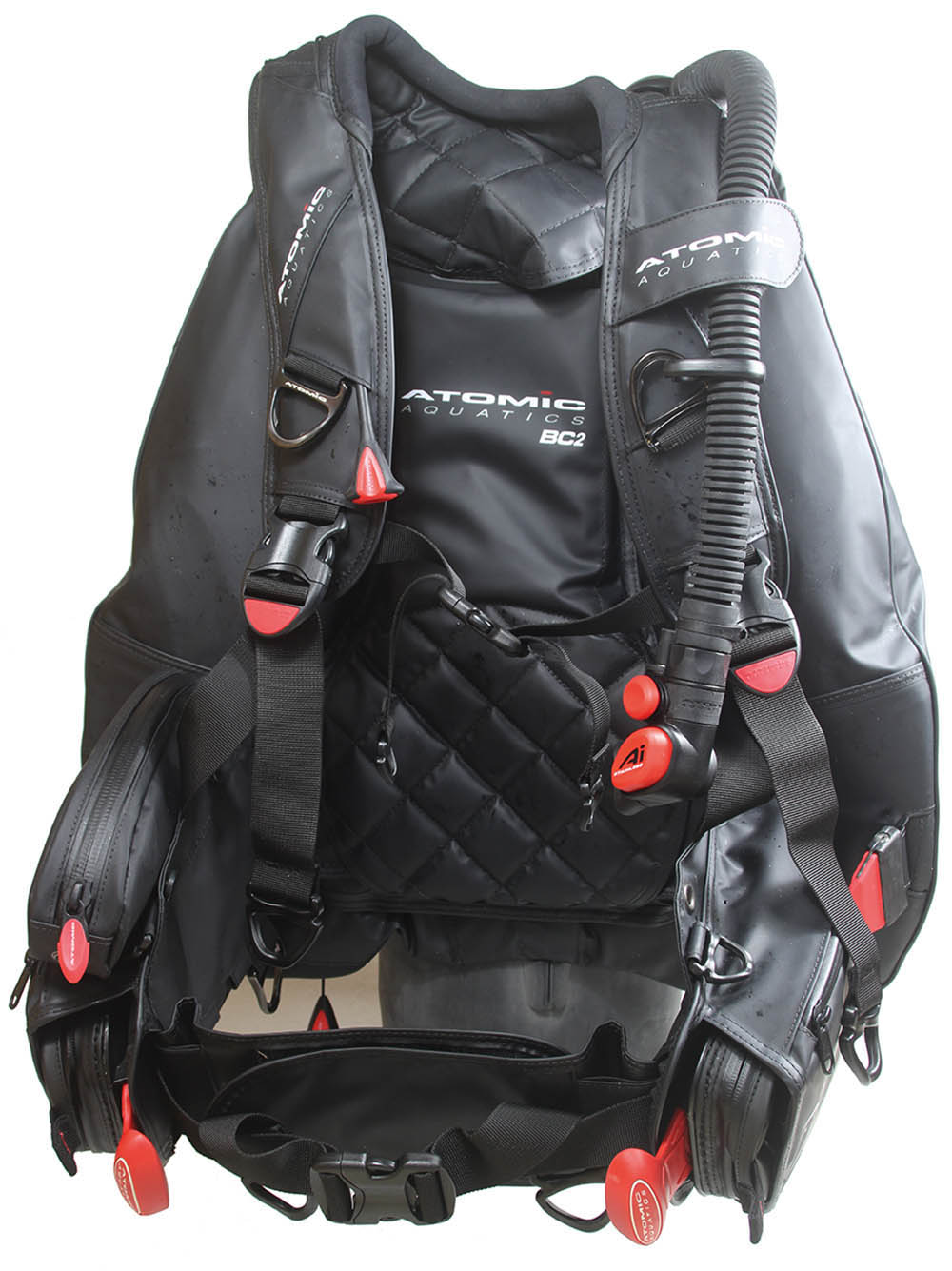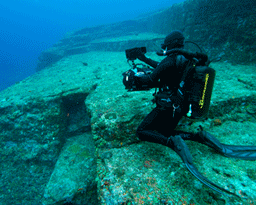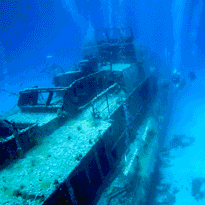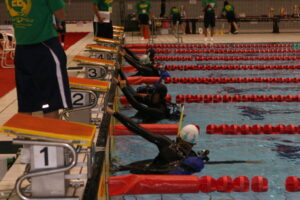
BC
Atomic BC2

Appeared in DIVER March 2020
The jacket-style Atomic BC1 I tested a while back was really quite astonishing. According to Atomic, everything about it had been reviewed and redesigned for optimum performance, from the water-shedding material to the shape of the toggles on the dump-valve cords.
Reassuringly expensive, Atomic set out to make the best jacket-style BC on the market, and delivered the BC1. It was, and is, very good indeed.
My only gripe was that I don’t really like jacket-style BCs. My old, long-retired Buddy Commando stab is still up in the loft ready to press into service if needed, but I haven’t used it for years, because I prefer wings.
Keenly aware of my preference (satire alert), Atomic has now developed the BC2, applying all the same attention to detail and eye-watering precision of manufacture to the reinvention of the wing that it put into the BC1. So I had to try it out.
The BC2 is supplied in a properly crafted heavyweight carry bag, custom-made for the job and with poppers to hold it closed when you’re transporting your new BC.
Yes, you might argue that it’s overkill, but it helps top up the value-for-money side of the buying equation. We will, inevitably, need to mention the price but, rest assured, Atomic has done everything it can to deliver a product that justifies the £1150 tag.
The Design
Take your new BC2 out of the bag and the third thing you’ll notice is that the basic design is one familiar to anyone who has ever used a diving wing, with a harness that fits around your upper body, and a vaguely triangular buoyancy cell that sits between your back and your cylinder.
This should place your adjustable buoyancy above your body when you’re swimming in a horizontal attitude, as I’m certain you do, helping you to maintain that desirable position and also providing a clean, clear front – which is why I like wings.
The first thing you’ll have noticed, however, is the weight. The BC2 is a hefty beast at 4.5kg in ML size, but really all that does is reassure you that it’s solidly built and likely to last a long time. It should add a degree of smugness to the smile on the face of any new owner.
Let’s start the tour with the buoyancy cell, which is made of the same double-laminated and water-repelling material chosen for the BC1, and is the second thing you’ll have noticed. When you climb back onto the boat after a dive, you’ll find that the material hasn’t soaked up any of the wet stuff and is almost immediately dry. It even managed to achieve that feat after a dip in a UK lake on a miserable winter’s day, so imagine how well it’ll work in tropical climes.
The cell is much larger at the bottom than the top, so when it’s part-inflated, as it will be during the dive, the gas will find itself naturally pooling somewhere midway along the length of your cylinder, and perhaps a bit further up your body than your hips. In other words, pretty much at your centre-mass.
Trim-weight pockets that can hold up to 2.5kg each are set at armpit height either side of the buoyancy cell, and Atomic suggests that you distribute your weights between the trim-pockets and the integrated weight-pouches to get the best position in the water.
And that fancy water-repellent material almost covers the zippers on the trim pockets to lessen the ingress of grit that could otherwise damage the teeth, thereby helping product life.
You get gas into the buoyancy cell using Atomic’s own SS1 power inflator, a very high-quality unit available in stainless steel, or titanium at extra cost.
Maximum lift varies from 14kg to 21kg, depending on the size of wing you need.
Even the corrugated hose, which runs up and over your left shoulder in conventional fashion, is notably solid and chunky, in keeping with the build of the rest of the BC2.
To vent gas you can pull the corrugated hose to open the valve behind your left shoulder, or raise it above your head and press the release button, or pull the appropriate triangular-for-better-ergonomics toggle to open valves set on your right shoulder or right kidney. All the valves are made of stainless steel for longevity.
The Harness
The harness is integrated into the overall design and features a soft, quilted pad for comfort on the inside of the backplate, and a curved hardplate to help hold your cylinder securely in place on the outside.
The pad is designed to be buoyancy-neutral, so despite the apparent bulk you should need no additional lead. Two plastic plates on the harness come factory-set according to the size of wing, but are adjustable for better fit and extra lumbar support if required.
You do, however, need to know that this is not a tech-diver’s harness to which you attach your choice of buoyancy cell. It’s actually a one-piece BC designed with the recreational diver in mind, and is single-cylinder only.
I say this, but of course there are stainless-steel, titanium-coated D-rings in various places on the harness, and the buoyancy cell is more than able to support a diver with three tanks at once, so you could use a large back-mounted bottle with a pair of side-slings quite easily.
That’s a configuration I’ll confess to finding more and more back-friendly on liveaboards, where the extra gas is useful for some dives and overkill on others.
Back to the harness, which has a pinch-buckle at each shoulder, a sternum-strap and a Velcro cummerbund supplemented with a pinch-clip strap at the waist. All the straps are easily adjusted to fit, and Atomic offers the BC2 in a range of sizes, with a chart to help you find the right one to get you started.
Camband & Weights
Which brings us to the camband, another item that Atomic has totally redesigned. Pretty much everyone else uses a combination of a 5cm strap and plastic buckle.
I’ve had a couple of buckles break over the years, though some creative re-threading has meant that I’ve never missed a dive. I’ve also seen cylinders slip when bands have stretched after they’ve got wet, but by and large they’re a perfectly usable and reliable solution.
Atomic disagrees, and developed its own ratcheting Cam-Lok system for the BC1, which has now been supplied with the BC2.
The functionality is the same, but it’s engineered for purpose using principles that come from ski-bindings.
The camband itself is now a broad rubberised strap with corrugations across the width. You drop the BC2 in place as usual and pull the band hand-tight. As you do that, you’ll see and hear a red plastic plate click over the corrugations on the band to hold it in place. Then you close the buckle to add some tension.
The excess camband tongue simply clicks into place on the band to stop it flapping around and keep it all neat and tidy. It’s the most secure camband system I’ve seen, and it doesn’t slacken off when it gets wet.
Finally, there’s the integrated-weight system on the waistband, with easily loaded pockets each holding up to 4.5kg of lead in pouches that fit in place easily and can be removed with one hand.
In total, then, you can use up to 14kg of lead, including the trim-weight pockets, enough to make the BC2 usable with either wet- or drysuits.
The review model also had a small auxiliary pocket, large enough to hold a small DSMB, attached above the right weight-pocket.
In Use
Time to go diving, and I used the BC2 with 12- and 15-litre cylinders. It coped beautifully with either, and was nice and comfy on the walk to the water, thanks to the generous padding. I had wondered if the padding claim would be delivered in practice and it was: more comfort, no extra lead required.
Once under water, I immediately checked that the gas addition and venting rates were properly sorted. As expected, I was easily able to add or dump small amounts of gas to cope with small changes in buoyancy, hovering easily as shallow as you like, yet when I simulated an emergency by blasting air into the BC2 with the inflate held fully open, I could vent gas fast enough to avoid ascending.
Nice. And there was always an appropriate dump-valve and toggle to hand, regardless of attitude.
Despite not using the trim-pockets and guessing where to set my bottle, I found it easy to hold a solid horizontal trim in my drysuit, the gas in the wing finding the right place for me to relax and let the BC2 do the work.
That means less gas used and longer dives, always good. If I were using a wetsuit, I’d expect to achieve the same result by using the trim-pockets and/or adjusting the cylinder position.
The harness held my cylinder securely to my body regardless of orientation. Forward, backward and barrel rolls didn’t faze it at all.
Back at the surface, the fully inflated wing held my mouth and nose well clear of the water courtesy of the wider, fatter section of wing being at hip height and therefore submerged to deliver maximum lift.
Stretchy sections of the harness ensured that there was no uncomfortable squeezing at full inflation.
None of which in-water performance is unique to the BC2, of course. Regardless of fancy materials or redesigned cambands, it’s the basic stuff any BC simply has to do, but the BC2 did it with ease, and was as comfy as I was walking back to the car as it had been when walking to the water an hour earlier.
Conclusion
Bottom line, the BC2 is a very nice piece of kit, very nice indeed, and my only problem with it is the price. I can’t even find it in my fiscally motivated heart to describe it as “expensive but reasonably priced bearing in mind the performance and quality of build”. But I really wish I could.
Presumably the equally pricey BC1 is selling well enough for Atomic to release the wing-style iteration, and I wish it and purchasers many happy years together. I liked it a lot and didn’t want to send it back.
Specs
TESTER> Mike Ward
PRICES> £1146
SIZES> Five from SM to XL
COLOUR> Black
WEIGHT> 4-5kg depending on size
CONTACT> atomicaquatics.com
The post Atomic BC2 appeared first on Divernet.
Read More BCs, Diver Tests, Gear Divernet

















